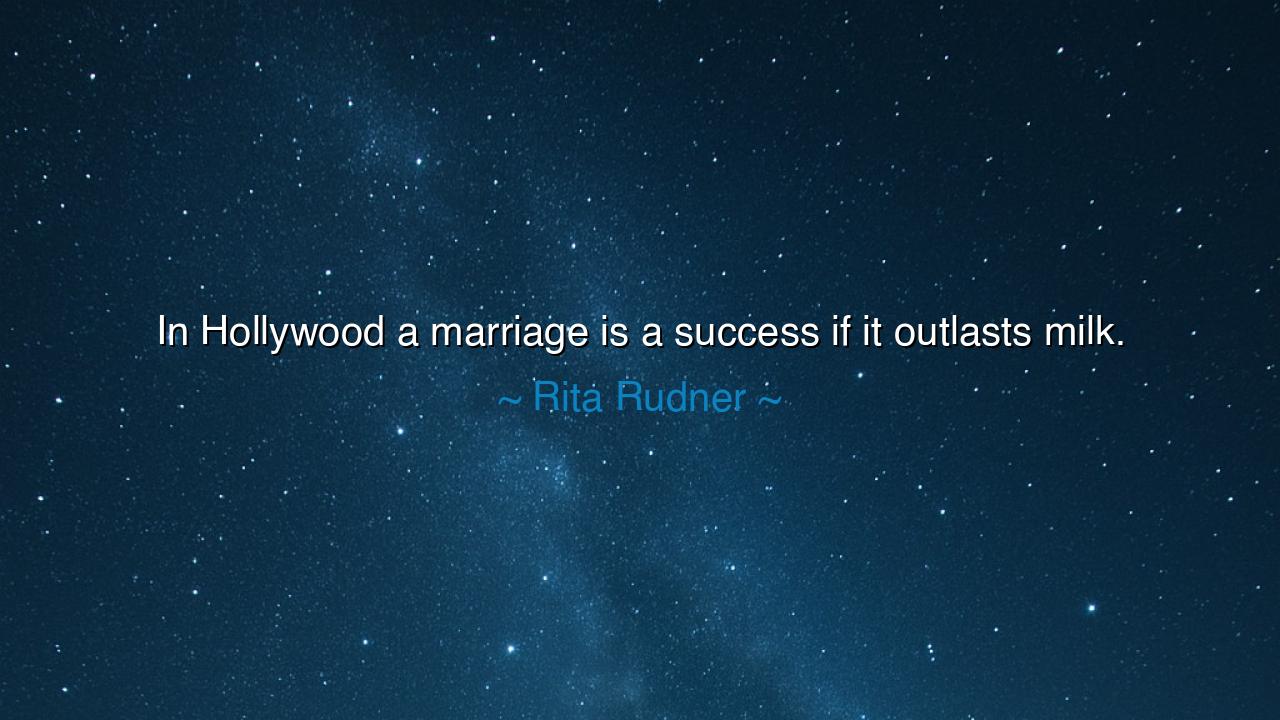
In Hollywood a marriage is a success if it outlasts milk.






“In Hollywood a marriage is a success if it outlasts milk.” So quipped Rita Rudner, with the sharp wit of one who sees beneath the glitter of fame. Though spoken in jest, her words strike like an arrow into the heart of truth. For in Hollywood, that land of lights and illusions, marriage often flickers as briefly as the expiration date stamped upon a carton of milk. What should be a sacred covenant of endurance is instead treated as a passing arrangement, discarded when its sweetness fades. Rudner’s humor unveils a deeper tragedy: the fragility of love when built upon vanity rather than devotion.
The ancients, who revered marriage as the cornerstone of society, would have marveled—and perhaps wept—at such a world. In their eyes, a union was not meant to vanish like vapor but to endure like stone. To compare a marriage’s lifespan to that of milk is to reveal how far some have fallen from the gravity of vows. For milk sours quickly, and when Rudner speaks of Hollywood marriages in this way, she implies they, too, are consumed with haste and abandoned without reverence. Her jest is a lament clothed in laughter.
Consider the many tales from Hollywood itself, where celebrities wed in splendor only to part within days. The marriage of Britney Spears to Jason Alexander, lasting a mere fifty-five hours, is one such tale, remembered less for love than for spectacle. Elizabeth Taylor, though brilliant in her art, was married eight times, her unions more famous for their brevity than their endurance. These stories illustrate the very spirit Rudner mocks: that in the land of stars, where appearances rule, commitment is often no stronger than a passing whim.
And yet, her words should not be read as condemnation of individuals alone, but as a mirror reflecting a culture of disposability. Just as society has grown accustomed to fast food, fleeting trends, and instant gratification, so too has it often come to treat love and marriage as consumables. What was once sacred—vows to endure in sickness and in health—is sometimes reduced to performance, as fragile as the illusions projected on the silver screen. Rudner’s humor exposes this, urging us to laugh, but also to awaken.
But there is also hope hidden in her jest. For to name the folly is the first step in healing it. By laughing at the brevity of such unions, she invites us to reflect on what makes a marriage truly successful. Not the length of years alone, but the quality of devotion. Not the glamour of beginnings, but the endurance through trials. A union that lasts beyond the fleeting, that does not sour with time but grows richer, is the true counter to the culture she mocks.
What lesson, then, shall we take? That love must not be treated as milk, perishable and disposable, but as wine, which deepens with age. A marriage should not be entered in haste or abandoned in boredom, but cultivated with patience, sacrifice, and loyalty. The heart must be trained to value permanence over novelty, substance over spectacle. For when we anchor our unions in enduring values, they outlast not only milk, but time itself.
Practical wisdom follows: choose your partner with care, not for glamour but for depth. Enter marriage not as a fleeting thrill but as a covenant of endurance. When conflicts arise, do not discard the bond but labor to strengthen it. And remember that the truest successes in love are often quiet, unseen by the world, but deeply known in the shared laughter, the shared burdens, the shared life that endures.
Thus, Rita Rudner’s jest, though wrapped in humor, carries the weight of wisdom. Marriage is not a carton of milk to be consumed and discarded, but a living covenant meant to endure the storms of time. Let us, therefore, rise above the fleeting ways of a culture of spectacle, and choose instead the ancient path of faithfulness. For in endurance lies not only success, but greatness.






AAdministratorAdministrator
Welcome, honored guests. Please leave a comment, we will respond soon